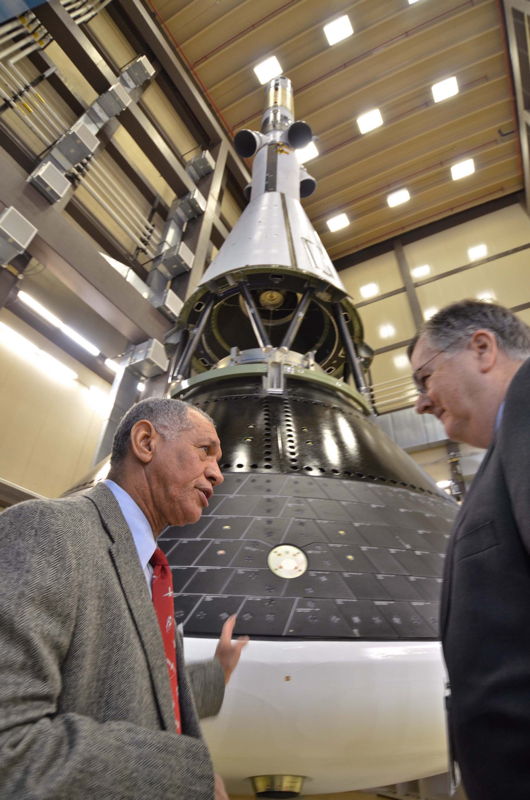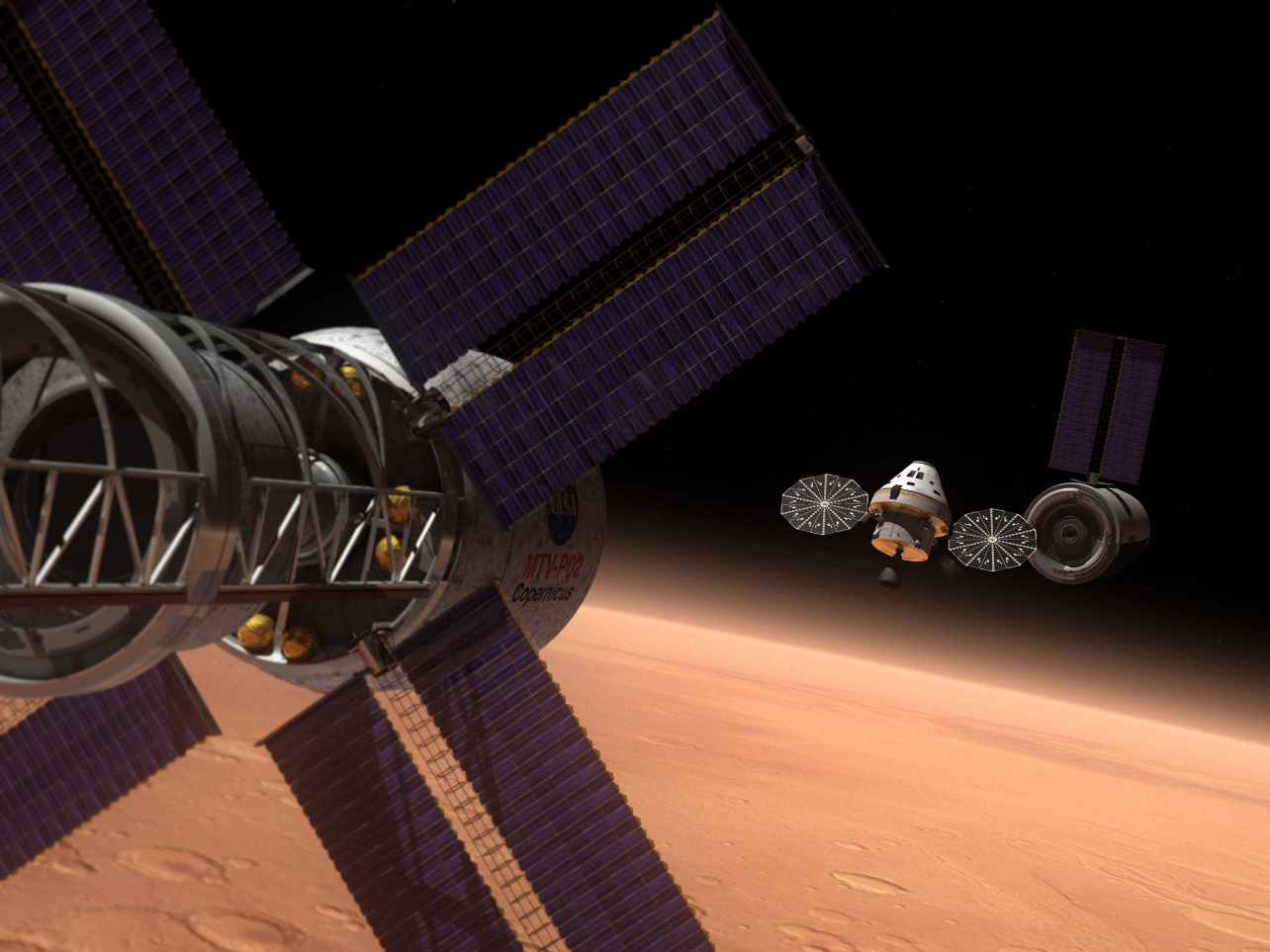
New Deep Space Capsule Passes NASA Chief's Inspection

DENVER — NASA chief Charles Bolden got an up-close look at the agency's next-generation vehicle for manned space exploration here during a Jan. 10 tour of Lockheed Martin, the company that's building the spacecraft.
Lockheed engineers have completed a suite of structural, acoustic and vibration tests on key components of the spaceship, which is known as the Orion Multi-Purpose Crew Vehicle. Those evaluations are critical to the fabrication of an Exploration Flight Test-1 (EFT-1) spacecraft, slated for launch in early 2014.
Bolden said he felt inspired looking at the stacked hardware stretching 53 feet (16 meters) up in the Reverberant Acoustics Laboratory at Lockheed Martin's Waterton facility.
"It's trivial, really trivial, but to me, it's important. It's big. It's robust," Bolden told reporters. "That was the most impressive thing to me today." [Photos of the Orion Spacecraft]
Orion is based heavily on a capsule concept developed for NASA's now-cancelled Constellation program. Lockheed Martin bills the vessel as America's first interplanetary spacecraft designed for human exploration of deep-space destinations such as asteroids or the moons of Mars.
Feeling of comfort
The unmanned 2014 EFT-1 mission will blast Orion into space aboard a Delta 4-Heavy rocket. The capsule will orbit Earth twice while climbing to an altitude of several thousand miles, then rocket back in a high-speed plunge to validate its heat shield and other systems.
Get the Space.com Newsletter
Breaking space news, the latest updates on rocket launches, skywatching events and more!
"2014 is not too far off. It's an important date for us," Bolden said.
When asked by SPACE.com what he thinks of the characterization, made by previous NASA Administrator Mike Griffin, that Orion is part of an "Apollo on steroids" approach, Bolden said he doesn't use "comical characterizations" and doesn't comment about what other people have said in the past.
"I found this to be an incredibly robust-looking vehicle," Bolden said. "It's a vehicle that gives me a feeling of comfort that I'm going to be able to keep my crews safe going to space and coming back. And that's what is most important to me."
Regarding future NASA destinations for Orion, Bolden said NASA doesn't just do human spaceflight anymore, or just robotic spaceflight.
"What we're finding is that there is an intersection between science, technology and human spaceflight…and they cannot exist without each other," he said, underscoring the value of automated precursors to set the stage for human flight back to the moon and onward on a trajectory toward Mars or an asteroid.
Budget outlook
On the topic of NASA's budget outlook, Bolden said that he was an "eternal optimist" and does not worry about sequestration of space agency money. "I have faith in the Congress and the president and everyone else that they will not allow us to get to a sequestration."
Members of Congress, Bolden added, "understand as much as we do that stability in budgets is important."
Bolden also addressed NASA's commitment to commercial cargo and crew services and private sector suppliers, saying that "commercial means I can go to the shelf and I can say I want one of those…one of those…one of those."
The job of NASA, Bolden continued, "is to facilitate the success of American industry to be able to get to the point where we can go to the shelf." In terms of commercial cargo and crew, he added "we're not there yet. But we're getting there."

Acoustic testing
Lockheed Martin is NASA's prime contractor for Orion. The gumdrop-shaped capsule can be used for both crew and cargo transportation and is comprised of a crew module, service module and launch abort system. [Infographic: How Orion Stacks Up]
The newly completed tests of Orion were successful, according to John Karas, vice president and general manager for human space flight at Lockheed Martin Space Systems Company.
"I just wanted to make sure that the spacecraft can outperform what we've advertised…and it does," Karas said.
Heather McKay, a Lockheed Martin propulsion engineer, said that recent acoustic testing of the Orion crew module/launch abort system structure involved hundreds of sensors planted throughout the hardware.
"We subjected it to the flight environment," to help validate computer models, McKay told SPACE.com. "Our chamber gets up to 150 decibels…like a rifle shot right next to your ear. It's pretty loud. All that sound…it's like a really loud rock concert."
Huge heat shield
Jacquelynn Gerlach, a Lockheed Martin design engineer, said that the Orion crew module/launch abort system is to be disassembled, with hardware headed for additional tests to assist in preparing for 2014's EFT-1 flight.
Protecting the underside of Orion's crew module is the heat shield — the largest structure of its kind in the world, measuring 16.5 feet (5 m) in diameter, Gerlach said. "It's big. And it's not going to get any less complicated for our flight."
Orion's Thermal Protection System advances heritage materials from the NASA's space shuttle and Apollo programs to create a next-generation system that can withstand the extreme environments of piloted deep space missions.
Karas said that the 2014 EFT-1 flight will do more than just validate the spacecraft's heat shield; separation of the launch abort system on the way is part of the test shot.
"We'll also be testing a full-up avionics system. All the software is the real flight software," Karas said. "We are going to carve our way through the atmosphere…landing in a five-mile square of ocean outside of San Diego. We'll be flying to that spot, and we'll be testing how we land and recover."
Leonard David has been reporting on the space industry for more than five decades. He is a winner of last year's National Space Club Press Award and a past editor-in-chief of the National Space Society's Ad Astra and Space World magazines. He has written for SPACE.com since 1999.
Join our Space Forums to keep talking space on the latest missions, night sky and more! And if you have a news tip, correction or comment, let us know at: community@space.com.

Leonard David is an award-winning space journalist who has been reporting on space activities for more than 50 years. Currently writing as Space.com's Space Insider Columnist among his other projects, Leonard has authored numerous books on space exploration, Mars missions and more, with his latest being "Moon Rush: The New Space Race" published in 2019 by National Geographic. He also wrote "Mars: Our Future on the Red Planet" released in 2016 by National Geographic. Leonard has served as a correspondent for SpaceNews, Scientific American and Aerospace America for the AIAA. He has received many awards, including the first Ordway Award for Sustained Excellence in Spaceflight History in 2015 at the AAS Wernher von Braun Memorial Symposium. You can find out Leonard's latest project at his website and on Twitter.










